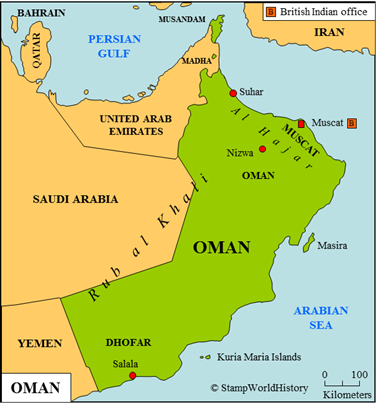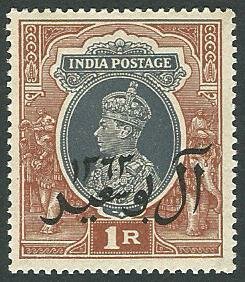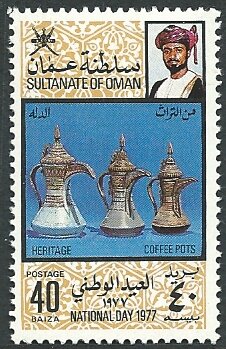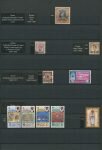عمان

Muscat & Oman
Sultanate

Oman
Sultanate
Quick reference
General issues: Sultanate Muscat & Oman 1966-1970, Sultanate Oman 1970-Present
Country name on general issues: Muscat & Oman, Oman
Special issues: Sultanate Muscat & Oman 1944, British Postal Agencies in Eastern Arabia 1948-1966
Currency: 1 Rupee = 16 Anna, 1 Anna = 12 Pie 1944-1957, 1 Rupee = 100 Naye Paise 1957-1966, 1 Rupee = 64 Baizas, 1 Rial = 1000 Baizas
Population: 586 000 in 1966, 3 632 000 in 2013
Political history Oman
Oman is a sultanate located on the Arabian peninsula in western Asia. The sultanate is named Oman from 1970 – until 1970 the official designation for the sultanate is Muscat & Oman. The names refer to 2 of the 3 historical regions in Oman: Dhofar, Muscat and Oman.
The sultanate of Oman has its golden age in the 18th century. At the time, it has possessions in eastern Africa, including Zanzibar, in Persia, in Baluchistan[1]A region in current Pakistan. and in what are now the United Arab Emirates. In the 19th century decline sets in when Oman has to cede most of its possessions. Zanzibar – that has become a separate sultanate – however, will be a tributary to Oman until 1964. Until 1958, Oman owns the exclave of Gwadar in Pakistan.
In the 19th century, the British influence in Oman increases and is confirmed through treaties. Sources evaluate the status of Oman differently: some consider Oman a protectorate, some consider it independent, some speak of ‘limited protection’. In any case, the British influence will be a factor of importance in Omani politics well into the 20th century. The Kuria Maria Islands are ceded to Great Britain in 1854 to be returned to Oman in 1964.
The sultan, in the 19th and the first half of the 20th century, has effective control only over the coastal area around the capital of Muscat. In other parts of current Oman – separated from Muscat by the Al Hajar mountains – the sultan has to confront opponents well into the 20th century. In 1920, the imam of Oman – the religious leader seated in Nizwa – gains a certain amount of self government to form the imamate of Oman. Relations between the sultan and the imam are sometimes tense and tensions escalate in 1954. With British support, the imam is ousted in 1959, which means the end of the imamate as a separate entity within Oman. The last major confrontation is with secessionist groups in the Dhofar region from 1962 until 1976. A conflict which is brought to an end, again, with – among others – British support.
Oman shows economic growth through the discovery of oil in the 1960’s. In the 1970’s, the sultan implements a set of economic, political and social reforms. In 2010, Oman is counted by the United Nations as the country that has shown most development in the previous forty years.
The borders of Oman for the better part lie in the ‘Rub Al Khali'[2]‘Rub al Khali’ translates to ‘Empty Quarter’ and are long undefined. The borders with Saudi Arabia are formalized in 1990, with Yemen in 1992 and with the United Arab Emirates in 1999.
Postal history Oman
The first – and until 1970 only – post office in Oman is opened in 1864 in the city of Muscat. It is part of the British Indian postal system and uses the stamps of British India. In 1944 a set of stamps is issued specifically to commemorate the 200th anniversary of the ruling Al Busaid dynasty. These being overprinted British Indian stamps. When India gains independence in 1947, the post office, for a short time, is run as part of the Pakistani postal service using stamps of Pakistan.
In 1948, the British Postal Agencies in Eastern Arabia take over the postal service in Oman. The Agencies are set up to service several countries in the region. The basic issues of the Agencies are stamps of Great Britain overprinted in the regional currency, the ‘value only’ issues. The Agencies function until the postal services are taken over by local postal authorities – in Oman in 1966.
Oman issues stamps from 1966 in the name of Muscat & Oman and from 1970 as Oman.[3]The worldwide catalogs list the issues discussed in different ways. Michel and Scott list the issues under Oman with subheadings for Muscat, Muscat & Oman and Oman. Stanley Gibbons has separate listings for the Muscat, Muscat & Oman, Oman and the British Postal Agencies in Eastern Arabia. Yvert has listings for Muscat and Oman. The Muscat listings are broken down to Muscat, the countries served at different times by the Agencies and Muscat & Oman. Please note that, although the catalogs have listings for Muscat, the official designation for the country, at the time, was Muscat & Oman.
Album pages
← Previous page: North BorneoNext page: Pakistan →





Let me add some minor corrections:
… Until 1966, the sultanate is called Muscat …
The official name of the sultanate, as used in international treaties and government documents, was “sultanate ofMuscat and Oman (and dependencies)” from the late 19th century onwards, no just “Muscat”.
… The Kuria Maria Islands are ceded to Great Britain in 1854 to be returned to Oman in 1964 …
The islands, ceeded to Queen Victoria by a deed of cession dated 14 July 1854, were returned with effect from 30 November 1967 (not 1964), in a Treaty of Cession signed in Salalah on 15 November 1967. The text can be found in UNTS Vol. 617, pp 319-325 as well as in Cmnd. 3505, Treaty Series 1968 No. 8.
… borders with Saudi Arabia are formalized in 1990, with Yemen in 1992 …
It the other way round: mith Yemen in 1990, with Saudia Arabia in 1992. Texts also to be found in the United Nations Treaty Series (UNTS).
Joachim Düster
Oman Studies Centre
Joachim
Thanks for your comments.
You are quite right about the name of the sultanate. Philatelic tradition has it to break up the listings for this country in Muscat, Muscat & Oman and Oman – but the official designation of the country is as you say Muscat & Oman and then Oman. I have corrected it. Also, I have added a note about the way the stamps discussed are listed in the catalogs.
The Kuria Maria Islands – typo I guess….
The dates for the boundary treatments I think are right. I checked the United Nations Treaty Series and they seem to confirm the dates as I have mentioned them. Do I miss something here?